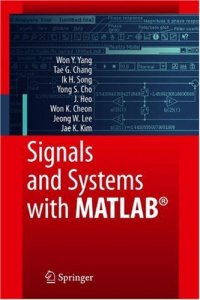
Ebook: Signals and Systems with MATLAB
Author: Won Young Yang (auth.)
- Genre: Mathematics // Wavelets and signal processing
- Tags: Fourier Analysis, Programming Techniques, Signal Image and Speech Processing
- Year: 2009
- Publisher: Springer-Verlag Berlin Heidelberg
- Edition: 1
- Language: English
- pdf
This book is primarily intended for junior-level students who take the courses on ‘signals and systems’. It may be useful as a reference text for practicing engineers and scientists who want to acquire some of the concepts required for signal proce- ing. The readers are assumed to know the basics about linear algebra, calculus (on complex numbers, differentiation, and integration), differential equations, Laplace R transform, and MATLAB . Some knowledge about circuit systems will be helpful. Knowledge in signals and systems is crucial to students majoring in Electrical Engineering. The main objective of this book is to make the readers prepared for studying advanced subjects on signal processing, communication, and control by covering from the basic concepts of signals and systems to manual-like introduc- R R tions of how to use the MATLAB and Simulink tools for signal analysis and lter design. The features of this book can be summarized as follows: 1. It not only introduces the four Fourier analysis tools, CTFS (continuous-time Fourier series), CTFT (continuous-time Fourier transform), DFT (discrete-time Fourier transform), and DTFS (discrete-time Fourier series), but also illuminates the relationship among them so that the readers can realize why only the DFT of the four tools is used for practical spectral analysis and why/how it differs from the other ones, and further, think about how to reduce the difference to get better information about the spectral characteristics of signals from the DFT analysis.
The fully comprehensive text covers most of the theoretical foundations and mathematical derivations that will be used in higher-level related subjects such as signal processing, communication, and control, minimizing the mathematical difficulty and computational burden.
Complying actively with the requirement by ABET (Accreditation Board for Engineering and Technology) on integrating computer tools, it illustrates the usage of MATLAB and Simulink for signal and system analysis and design.
The ideas are developed gradually with continual reference to the practical situations where they would be applicable. Many worked examples have been included in order to help develop the idea and to illustrate the material as it is presented. Throughout the book continuous-time and discrete-time signals/systems have been developed in parallel to save the time/space for explaining the two similar ones as far as there is no concern over confusion. This has the advantage of being able to contrast and compare the two ones so that ideas, insights, and intuition acquired in one can help understanding the other one and the differences between them are exploited to sharpen an understanding of the distinctive properties of each. That approach is also expected to make the readers become exposed to and interested in the relationship between continuous-time and discrete-time signals/systems above understanding each one of them individually.